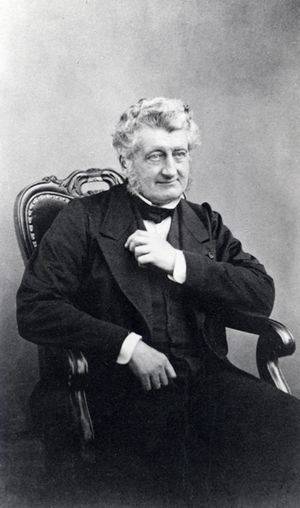Adolphe-Théodore Brongniart facts for kids
Quick facts for kids
Adolphe-Théodore Brongniart
|
|
|---|---|
 |
|
| Born | 14 January 1801 Paris, France
|
| Died | 18 February 1876 (aged 75) |
| Known for | Histoire des végétaux fossiles |
| Parent(s) |
|
| Relatives | Alexandre-Théodore Brongniart (grandfather), architect |
| Awards | Foreign member, Royal Swedish Academy of Sciences, Wollaston Medal (1841), Société Botanique de France (first president), Commander, Légion d'honneur (1864) |
| Scientific career | |
| Fields | |
| Institutions | Muséum national d'Histoire naturelle |
| Author abbrev. (botany) | Brongn. |
Adolphe-Théodore Brongniart (born January 14, 1801 – died February 18, 1876) was a famous French botanist. He was the son of Alexandre Brongniart, a geologist, and the grandson of Alexandre-Théodore Brongniart, an architect.
Brongniart is often called the "father of paleobotany". This is because he did important early work on how plants that are now extinct are related to plants living today. His most important book about plant fossils was called Histoire des végétaux fossiles (which means "History of Fossil Plants"). He worked at the Muséum national d'Histoire naturelle (National Museum of Natural History) in Paris for many years.
Discovering Ancient Plants
Adolphe Brongniart was a very hard-working scientist. He wrote many books and papers. In 1822, he published a paper about how fossil plants could be grouped and where they were found. This led to more studies about how extinct plants relate to plants we see today.
His biggest work was the Histoire des végétaux fossiles. This book helped him earn the title "father of paleobotany". In this book, he organized fossil plants by how closely they were related to living plants. This way of classifying plants became the basis for much of the later work in paleobotany.
Brongniart's work was also important because it showed how different plant groups appeared over time.
- In the Palaeozoic era (very old times), ferns and similar plants were most common.
- In the Mesozoic era (the time of dinosaurs), Gymnosperms (like pine trees) were dominant.
- In the Cenozoic era (more recent times), Angiosperms (flowering plants) became the most common.
He also studied the structure of ancient tree-like plants called Sigillaria. These plants are related to modern club mosses. Towards the end of his life, he researched fossil seeds. His detailed findings were published after he passed away.
Other Plant Studies
Brongniart was interested in many areas of botany. This included plant anatomy (how plants are built) and the classification of seed-producing plants.
One of his most notable achievements was his study titled Sur la génération et le développement de l'embryon des Phanérogames. This translates to "On the generation and development of the spermatophyte embryo". In this work, he was the first to properly describe how pollen develops. He also confirmed the discovery of the pollen-tube, which helps plants reproduce.
He also did important research on the structure and functions of leaves. He studied the cuticle, which is a protective layer on plant leaves. He also looked at the structure of cycad stems, which are a type of ancient plant.
Brongniart also helped create a system for classifying plants. This system was used and improved by other scientists for many years. It was only replaced when DNA research became possible.
Besides his scientific work, Brongniart was involved in education and also cared a lot about farming and gardening. In 1824, he helped start a science journal called Annales des Sciences Naturelles. He also founded the Société Botanique de France (Botanical Society of France) in 1854 and was its first president.
Adolphe Brongniart died in Paris in 1876. He is buried in the Père Lachaise Cemetery.
See also
 In Spanish: Adolphe Theodore Brongniart para niños
In Spanish: Adolphe Theodore Brongniart para niños

